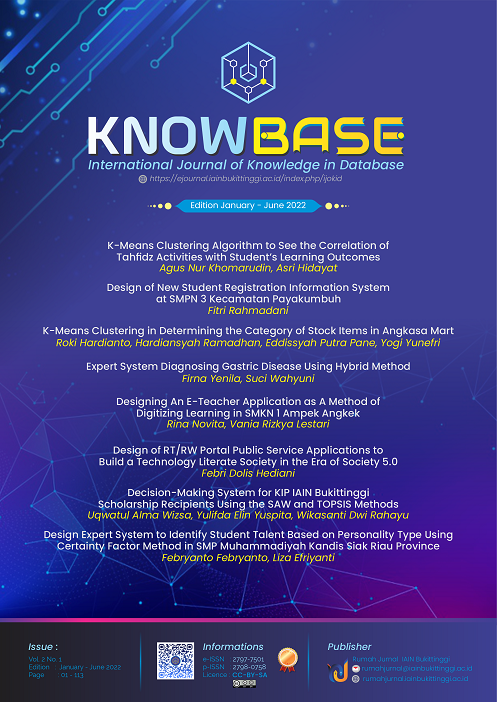K-Means Clustering Algorithm to See the Correlation of Tahfidz Activities with Student’s Learning Outcomes
DOI:
https://doi.org/10.30983/ijokid.v2i1.5672Keywords:
Data Mining, K-Means, Clustering, Learning OutcomesAbstract
Computer technology is currently used as a tool to support educational activities and assist teachers in quickly, precisely, and accurately processing student data. The Qur'an has been memorized by many students at MAN 1 Bukittinggi as a result of long-running Tahfidz activities, which have also helped them stand out in teaching and learning evaluation meetings held at the end of each semester. In conveying the activities which take place in the field, the Tahfidz teacher has not used real data and certainly will not describe the real state of Tahfidz activity and student memorization. The solution to this problem is applying the Data Mining technique for grouping data of Tahfidz activity and student learning outcomes, in order to discover the correlation between the two and whether there is any effect or not. The data processed in this research is Tahfidz activity data and student learning outcomes data for class XI (eleven) sourced from piles of data, the data used are Tahfidz memorization data, Tahfidz scores, and student grades at MAN 1 Bukittinggi. The data mining development methodology used in this research is Cross-Industry Standart Process for Data Mining (CRIPS-DM). The results of the research by applying the K-Means Clustering algorithm has produced two clusters. The first cluster shows the characteristic that Tahfidz activity doesn’t have significant effect on student learning outcomes. The second cluster shows the characteristics that Tahfidz activity has a significant effect on student learning outcomes.  The data from the clustering of each cluster is then analyzed and the results of the cluster analysis are used by the school as a consideration in evaluating Tahfidz activity and learning outcomes whether it has been effective or not at MAN 1 Bukittinggi.
References
D. Triyansyah and D. Fitrianah, “Analisis Data Mining Menggunakan Algoritma K-Means Clustering Untuk Menentukan Strategi Marketing,†J. Telekomun. dan Komput., vol. 8, no. 3, p. 163, 2018, doi: 10.22441/incomtech.v8i3.4174.
J. O. Ong, “Implementasi Algotritma K-means clustering untuk menentukan strategi marketing president university,†J. Ilm. Tek. Ind., vol. vol.12, no, no. juni, pp. 10–20, 2013.
Agus Nur Khomarudin, “Teknik Data Mining: Algoritma K-Means Clustering,†J. Ilmu Komput., pp. 1–12, 2016, [Online]. Available: https://ilmukomputer.org/category/datamining/.
E. Irfiani and S. S. Rani, “Algoritma K-Means Clustering untuk Menentukan Nilai Gizi Balita,†J. Sist. dan Teknol. Inf., vol. 6, no. 4, p. 161, 2018, doi: 10.26418/justin.v6i4.29024.
H. Sulastri and A. I. Gufroni, “The Application of Data Mining in the Grouping of Thalassemia Patients,†J. Nas. Teknol. dan Sist. Inf., vol. 3, no. 2, pp. 299–305, 2017.
R. Rosmini, A. Fadlil, and S. Sunardi, “Implementasi Metode K-Means Dalam Pemetaan Kelompok Mahasiswa Melalui Data Aktivitas Kuliah,†It J. Res. Dev., vol. 3, no. 1, pp. 22–31, 2018, doi: 10.25299/itjrd.2018.vol3(1).1773.
G. S. Nugraha and H. Hairani, “Aplikasi Pemetaan Kualitas Pendidikan di Indonesia Menggunakan Metode K-Means,†J. MATRIK, vol. 17, no. 2, pp. 13–23, 2018, doi: 10.30812/matrik.v17i2.84.
A. Nur Khomarudin, S. Zakir, R. Novita, Endrawati, M. Zahiri Bin Awang Mat, and E. Maiyana, “K-Mean Clustering Algorithm in Grouping Prospective Scholarship Recipients,†J. Phys. Conf. Ser., vol. 1779, no. 1, 2021, doi: 10.1088/1742-6596/1779/1/012007.
A. Asroni, H. Fitri, and E. Prasetyo, “Penerapan Metode Clustering dengan Algoritma K-Means pada Pengelompokkan Data Calon Mahasiswa Baru di Universitas Muhammadiyah Yogyakarta (Studi Kasus: Fakultas Kedokteran dan Ilmu Kesehatan, dan Fakultas Ilmu Sosial dan Ilmu Politik),†Semesta Tek., vol. 21, no. 1, pp. 60–64, 2018, doi: 10.18196/st.211211.
E. U. Oti, M. O. Olusola, F. C. Eze, and S. U. Enogwe, “Comprehensive Review of K-Means Clustering Algorithms,†Int. J. Adv. Sci. Res. Eng., vol. 07, no. 08, pp. 64–69, 2021, doi: 10.31695/ijasre.2021.34050.
W. Purba, S. Tamba, and J. Saragih, “The effect of mining data k-means clustering toward students profile model drop out potential,†J. Phys. Conf. Ser., vol. 1007, no. 1, 2018, doi: 10.1088/1742-6596/1007/1/012049.
S. Hameetha Begum, “Data Mining Tools and Trends – An Overview,†Int. J. Emerg. Res. Manag. &Technology, vol. ISSN, no. February, pp. 2278–9359, 2013.
Downloads
Published
How to Cite
Issue
Section
Citation Check
License
Copyright (c) 2022 Agus Nur Khomarudin, Asri Hidayat

This work is licensed under a Creative Commons Attribution-ShareAlike 4.0 International License.
Authors who publish with this journal agree to the following terms:
- Authors retain copyright and grant the journal right of first publication with the work simultaneously licensed under a Creative Commons Attribution License that allows others to share the work with an acknowledgment of the work's authorship and initial publication in this journal.
- Authors are able to enter into separate, additional contractual arrangements for the non-exclusive distribution of the journal's published version of the work (e.g., post it to an institutional repository or publish it in a book), with an acknowledgment of its initial publication in this journal.
- Authors are permitted and encouraged to post their work online (e.g., in institutional repositories or on their website) prior to and during the submission process, as it can lead to productive exchanges, as well as earlier and greater citation of published work (See The Effect of Open Access).



